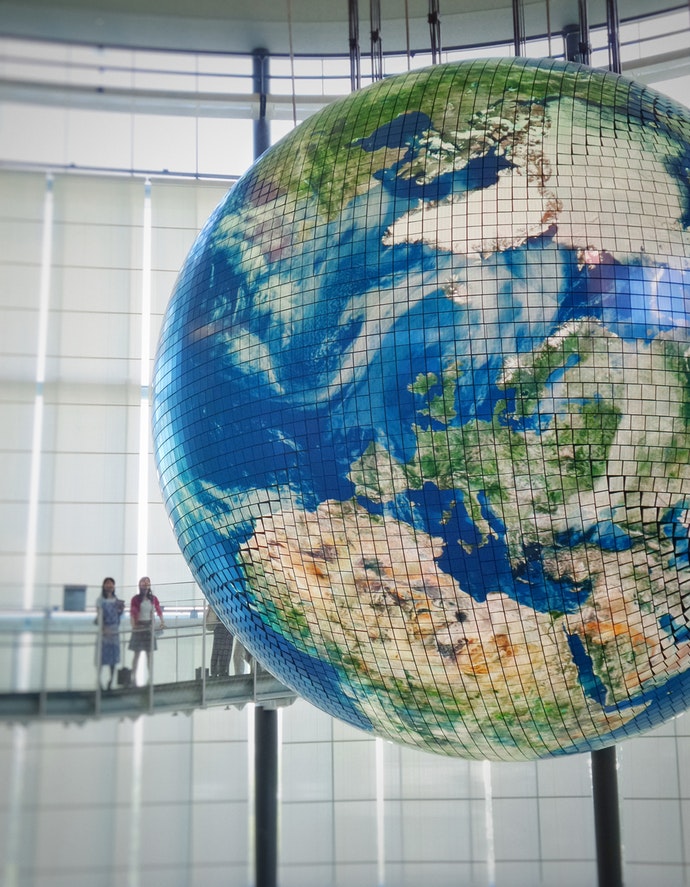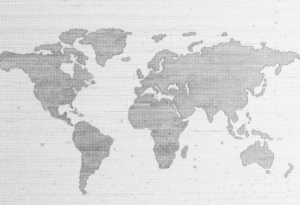The world is a common name for the whole of human civilization, specifically human experience, history, or the human condition in general, worldwide, i.e. anywhere on Earth.
The world is the planet Earth and all life upon it, including human civilization.[1] In a philosophical context, the “world” is the whole of the physical Universe, or an ontological world (the “world” of an individual). In a theological context, the world is the material or the profane sphere, as opposed to the celestial, spiritual, transcendent or sacred spheres. “End of the world” scenarios refer to the end of human history, often in religious contexts.
The history of the world is commonly understood as spanning the major geopolitical developments of about five millennia, from the first civilizations to the present. In terms such as world religion, world language, world government, and world war, the term world suggests an international or intercontinental scope without necessarily implying participation of every part of the world.
The world population is the sum of all human populations at any time; similarly, the world economy is the sum of the economies of all societies or countries, especially in the context of globalization. Terms such as “world championship”, “gross world product”, and “world flags” imply the sum or combination of all sovereign states.
Geopolitics
Geopolitics (from Greek γῆ gê “earth, land” and πολιτική politikḗ “politics”) is the study of the effects of geography (human and physical) on politics and international relations.[1] While geopolitics usually refers to countries and relations between them, it may also focus on two other kinds of states: de facto independent states with limited international recognition and; relations between sub-national geopolitical entities, such as the federated states that make up a federation, confederation or a quasi-federal system.
At the level of international relations, geopolitics is a method of studying foreign policy to understand, explain and predict international political behavior through geographical variables. These include area studies, climate, topography, demography, natural resources, and applied science of the region being evaluated.[2]
Geopolitics focuses on political power in relation to geographic space. In particular, territorial waters and land territory in correlation with diplomatic history. Academically, geopolitics analyses history and social science with reference to geography in relation to politics. Outside academia, a variety of groups offer a geopolitical prognosis, including non-profit groups and for-profit private institutions (such as brokerage houses[3] and consulting companies[4]).Topics of geopolitics include relations between the interests of international political actors, interests focused to an area, space, geographical element or ways, relations which create a geopolitical system.[5]“Critical geopolitics” deconstructs classical geopolitical theories, by showing their political/ideological functions for great powers during and after the age of imperialism.[6]
According to Christopher Gogwilt and other researchers the term is currently being used to describe a broad spectrum of ideas, in a general sense used as “a synonym for internal political relations”, but more specifically “to imply the global structure of such relations”, which builds on “early-twentieth-century term for a pseudoscience of political geography” and other pseudoscientific theories of historical and geographic determinism.
World economy
The world economy or global economy is the economy of the world, considered as the international exchange of goods and services that is expressed in monetary units of account (money).[1] In some contexts, the two terms are distinguished: the “international” or “global economy” being measured separately and distinguished from national economies while the “world economy” is simply an aggregate of the separate countries’ measurements. Beyond the minimum standard concerning value in production, use and exchange the definitions, representations, models and valuations of the world economy vary widely. It is inseparable from the geography and ecology of Earth.
It is common to limit questions of the world economy exclusively to human economic activity and the world economy is typically judged in monetary terms, even in cases in which there is no efficient market to help valuate certain goods or services, or in cases in which a lack of independent research or government cooperation makes establishing figures difficult. Typical examples are illegal drugs and other black market goods, which by any standard are a part of the world economy, but for which there is by definition no legal market of any kind.
However, even in cases in which there is a clear and efficient market to establish a monetary value, economists do not typically use the current or official exchange rate to translate the monetary units of this market into a single unit for the world economy since exchange rates typically do not closely reflect worldwide value, for example in cases where the volume or price of transactions is closely regulated by the government.
Rather, market valuations in a local currency are typically translated to a single monetary unit using the idea of purchasing power. This is the method used below, which is used for estimating worldwide economic activity in terms of real United States dollars or euros. However, the world economy can be evaluated and expressed in many more ways. It is unclear, for example, how many of the world’s 7.13 billion people have most of their economic activity reflected in these valuations.
As of 2017, the following 15 countries or regions have reached an economy of at least US$2 trillion by GDP in nominal or PPP terms: Brazil, China, France, Germany, India, Indonesia, Italy, Japan, South Korea, Mexico, Russia, Turkey, the United Kingdom, the United States and the European Union.
Current Affairs
Although the world continues to advance economically, scientifically and technologically, it is an uneven and disproportionate development by countries and continents that for many reasons do not allow a greater reduction of poverty and as a sample are the following data
Homelessness in the United States
In the year 2009, one out of 50 children or 1.5 million children in United States of America will be homeless each year. There were an estimated 57,849 homeless veterans estimated in the United States during January 2013, or 12 percent of all homeless adults. Just under 8 percent of homeless U.S. veterans are female. Texas, California and Florida have the highest numbers of unaccompanied homeless youth under the age of 18, comprising 58% of the total homeless under 18 youth population.Homelessness affects men more than women. In the United States, about 60% of all homeless adults are men.
Because of turnover in the population of people that are homeless, the total number of people who experience homelessness for at least a few nights during the course of a year is thought to be considerably higher than point-in-time counts. A 2000 study estimated the number of such people to be between 2.3 million and 3.5 million.According to Amnesty International USA, vacant houses outnumber homeless people by five times. A December 2017 investigation by Philip Alston, the U.N. Special Rapporteur on extreme poverty and human rights, found that homeless persons have effectively been criminalized throughout many cities in the United States.
Causes of homelessness in the United States include lack of affordable housing, divorce, lawful eviction, negative cash flow, post traumatic stress disorder, foreclosure, fire, natural disasters (hurricane, earthquake, or flood), mental illness, physical disability, having no family or supportive relatives, substance abuse, lack of needed services, elimination of pensions and unemployment entitlements, no or inadequate income sources (such as Social Security, stock dividends, or annuity), poverty (no net worth), gambling, unemployment, and low-paying jobs. Homelessness in the United States affects many segments of the population, including families, children, domestic violence victims, ex-convicts, veterans, and the aged. Efforts to assist the homeless include federal legislation, non-profit efforts, increased access to healthcare services, supportive housing, and affordable housing.
Global inequality
The economies of the world have developed unevenly, historically, such that entire geographical regions were left mired in poverty and disease while others began to reduce poverty and disease on a wholesale basis. This was represented by a type of North–South divide that existed after World War II between First world, more developed, industrialized, wealthy countries and Third world countries, primarily as measured by GDP. From around 1980, however, through at least 2011, the GDP gap, while still wide, appeared to be closing and, in some more rapidly developing countries, life expectancies began to rise.However, there are numerous limitations of GDP as an economic indicator of social “well-being.”
Overall equality across humanity, considered as individuals, has improved very little. Within the decade between 2003 and 2013, income inequality grew even in traditionally egalitarian countries like Germany, Sweden and Denmark. With a few exceptions—France, Japan, Spain—the top 10 percent of earners in most advanced economies raced ahead, while the bottom 10 percent fell further behind.[72] By 2013, a tiny elite of multibillionaires, 85 to be exact, had amassed wealth equivalent to all the wealth owned by the poorest half (3.5 billion) of the world’s total population of 7 billion. Country of citizenship (an ascribed status characteristic) explains 60% of variability in global income; citizenship and parental income class (both ascribed status characteristics) combined explain more than 80% of income variability.

According to the world inequality report “Our global wealth inequality estimates since 1980 therefore combine data from three large regions: the United States, China, and Europe. Europe itself is represented by three countries (France, Spain, and the United Kingdom), which on the basis of other countries for which we have wealth inequality data (in particular, Sweden and Germany) appear to be broadly representative.
Available data show that global wealth inequality is extreme and on the rise
At the global level (represented by China, Europe, and the United States), wealth is substantially more concentrated than income: the top 10% owns more than 70% of the total wealth.1 The top 1% wealthiest individuals alone own 33% of total wealth in 2017. This figure is up from 28% in 1980. The bottom 50% of the population, on the other hand, owns almost no wealth over the entire period (less than 2%). Focusing on a somewhat larger group, we see that the bottom 75% saw its share oscillate around 10%. Wealth concentration levels would probably be even higher if Latin America, Africa, and the rest of Asia were included in the analysis, as most people in these regions would be in the poorer parts of the distribution. We leave this to future editions of the World Inequality Report.” (wir2018.wid.world).
From Wikipedia, the free encyclopedia, for more about this and other articles click here


